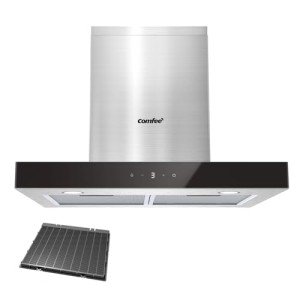
Cooker Extractor
Add a review FollowOverview
-
Founded Date June 7, 1952
-
Posted Jobs 0
-
Viewed 87
Company Description
A Brief History Of Kitchen Hood History Of Kitchen Hood

Kitchen Hood Extractor Fan: An Essential Appliance for Modern Cooking
In the heart of every home lies the kitchen, a location where cooking imagination flourishes, and delicious scents penetrate the air. Nevertheless, with deliciousness typically comes the challenge of smoke, grease, and unwanted odors. This is where the kitchen hood extractor fan comes into play– an important appliance designed to ensure your cooking environment remains fresh and pleasurable.
What Is a Kitchen Hood Extractor Fan?
A Kitchen Hood Extractor Fan, www.xeniabatchelor.Top,, also understood merely as a range hood or cooker hood, is a gadget set up above the cooking location to ventilate and purify the air. By getting rid of air-borne grease, smoke, steam, and smells, these fans not just boost indoor air quality however also avoid unpleasant biological responses, such as mold growth or remaining aromas.
Kinds Of Kitchen Hood Extractor Fans
There are numerous kinds of kitchen hood extractor fans, each fit to various kitchen layouts and user requirements. Below is a comparison that highlights the most typical types:
| Type | Description | Pros | Cons |
|---|---|---|---|
| Wall-Mounted Hoods | Set up versus a wall, normally above the stove. | Space-saving; modern aesthetic. | Requires wall space; may limit height. |
| Island Hoods | Suspended from the ceiling above an island cooktop. | Appealing; effective for open designs. | Installation intricacy; more expensive. |
| Under-Cabinet Hoods | Mounted below kitchen cabinets, directly above the stove. | Less visible; blends into decoration. | Limited ventilation location. |
| Downdraft Hoods | Retractable vents that rise from the counter top. | Discreet; perfect for minimalist styles. | Less effective suction; greater price. |
| Professional Hoods | Sturdy models utilized in commercial kitchens. | High extraction rates; durable. | Noisy; requires significant installation area. |
Which Type is Right for You?
Choosing the ideal kitchen hood extractor fan depends upon numerous elements:
- Kitchen Layout: Consider whether your stove is on a wall, island, or incorporated into a cabinet.
- Ventilation Needs: Evaluate how much cooking you do. If you frequently fry or grill foods, a stronger extractor fan might be necessary.
- Looks: Depending on your kitchen style, you may prefer a modern appearance or something that mixes seamlessly with your kitchen cabinets.
Advantages of Installing a Kitchen Hood Extractor Fan
The installation of a kitchen hood extractor fan offers various benefits:
-
Improved Air Quality: By getting rid of pollutants, smells, and excess wetness, these fans assist preserve a much healthier kitchen environment.
-
Security of Surfaces: They avoid grease and smoke from deciding on cabinets, walls, and countertops, maintaining the appearance and durability of your kitchen fixtures.
-
Comfortable Cooking: A well-ventilated kitchen keeps the air cooler and more workable, specifically during summertime months or when preparing several meals.
-
Increased Property Value: Modern kitchens with quality home appliances include to the appeal and market value of a home.
-
Compliance with Safety Standards: Proper ventilation reduces the risk of carbon monoxide gas accumulation and fire dangers from grease buildup.
Installation Considerations
When investing in a kitchen hood extractor fan, it’s vital to consider the setup process. Here is a step-by-step introduction:
-
Determine the Right Size: The hood ought to be broader than the cooking surface area by at least 3 inches on each side.
-
Choose Ducted or Ductless: Ducted hoods vent air outside, while ductless hoods filter air and recirculate it. Ductless is frequently easier to set up.
-
Usage Professional Help: Although some might choose DIY setup, employing an expert can guarantee appropriate setup and compliance with building regulations.
-
Select the Right Height: Install wall-mounted hoods 24-30 inches above the cooking surface; island hoods ought to be 30-36 inches above.
Frequently Asked Question about Kitchen Hood Extractor Fans
Q1: How do I tidy my kitchen hood extractor fan?A: Regular cleaning is vital for keeping efficiency. Detach the hood, remove filters, and clean them utilizing soap and warm water or a degreaser. Wipe the exterior with mild cleaning agent. Q2: How typically need to I run my kitchen
hood extractor fan?A: It is recommended to run the fan while cooking and for an additional 10-15 minutes later to remove recurring odors and moisture. Q3: What is the ideal CFM(Cubic Feet per Minute)for a kitchen hood?A: CFMs
depend on the cooking activity. A basic guideline is 100 CFM for every direct foot of cooking surface area. Heavy cooking may need 300 CFM or higher. Q4: Can I set up a kitchen hood myself?A: While DIY installation is possible, seeking advice from a professional can ensure
compliance with security policies and expert-level setup. Q5: Are kitchen hood extractor fans noisy?A: Noise levels differ by design. Higher-end designs typically include noise-reducing functions. Consider looking at the sones
score when selecting a fan. Buying a kitchen hood extractor fan is a wise option for anyone aiming to boost their cooking experience while improving air quality and looks. By understanding the various types,
benefits, and installation considerations, house owners can make educated choices that line up with their specific requirements. Whether cooking for family or hosting good friends, a well-ventilated kitchen is key to keeping the culinary experience pleasurable and gratifying.